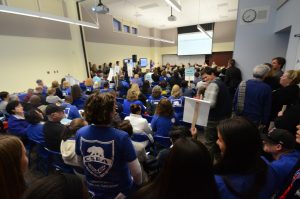12 Chapter 9: News Stories
Types of News Stories

There are a variety of news story types, but the three that every writer should know are speeches, meetings and obituaries. Sound morbid and boring? Sometimes. It is still broccoli news, after all. But the skills you can glean from such stories reverberate through all news stories. If a reporter knows how to write these three types of news stories, they have the skills to handle more complicated assignments.
Meetings
Any reporter working for themselves, or a media outlet, will find that they’ll need to cover a meeting. Whether it’s for a government agency, school or local HOA, meetings are where decisions get made. Those decisions impact readers, so meetings must be covered.
Remember the French fry example from a previous chapter? The watchdog role of the press focuses on government agencies such as schools and cities, where decisions are made that affect readers, their families and their wallets. The average reader doesn’t have time to attend every meeting as a watchdog to those in power. This is where reporters come in. Their job is to pay attention.
After posting an agenda and holding a few meetings, the school district in the city where I live changed the school that my children attend. The district’s decision impacted my family greatly, and no news organization covered it. If there were more consistent coverage of the local school district, my family would have had more warning of and input on that fateful decision.

Advance Story
Part of a reporter’s job is to routinely skim the agendas of meetings that might impact their readers and report about those meetings. But as in the case of my school district, learning what happened after the fact won’t help readers. They need to know about meetings before they occur. A good news writer will produce something called an advance story, which is an objective news story about what’s scheduled to happen at a meeting.
Example:
SAN MARCOS – The San Marcos Unified School District is set to consider changing the boundaries for its two high schools, according to the agenda.
The district will meet on Sept. 4 to determine whether to change the school lines …
Note how this story is written to inform the reader immediately what the meeting is about. Even if the reader doesn’t have a child in the school district, a change in school boundaries can affect property values. An advance story doesn’t have to be long, but it should explain meeting details in a straightforward, well-written way using one of the story formats outlined in Chapter 7.
An advance story should have a one-sentence lead that starts with the group that’s meeting or the meeting’s topic.
Example:
SAN MARCOS – The city may get a new park if the city council approves it at a meeting set for Wednesday, officials said.
The city council is set to meet at 3 p.m. in the city chambers at 200 Main St. to consider approving the $4 million project.
Meeting Story
Once a reporter produces an advance story, the next step is covering the meeting. A meeting story is an objective news story published on a deadline immediately after the meeting is over. This type of story uses the inverted pyramid format with a lead of one to two sentences that tells the meeting’s outcome. It might be tempting to report the story based on the agenda order, but that would weigh the story down and focus on the wrong items.
The most newsworthy items are rarely at the beginning of the meeting. Instead, they are often in the section called “New Business” or “Action.” Also, the actual decision on an item is always the last thing a governing body does. They vote on any action at the end of the discussion. Skip chronological order and lead with the vote.
Tips on covering a meeting
- Before the meeting, do your research.
- Before you go to the meeting, pre-write the story with background information and reporting.
- Go early and introduce yourself to the people running the meeting
- Have a copy of the agenda and all related items. Most government groups have extensive background for each topic that helps reporters
- When deadlines permit, stay late.
- Take notes manually and record. Although most meetings are recorded, it often takes a week to get that recording from municipalities. Have your own copy.
- Develop your own shorthand for taking notes in case technology fails you.
- Write down any interesting quotes.
- Focus on the item that the crowd is there to hear.
- If members of the public don’t attend, focus on the item that the officials argue about.
- If there’s no argument, focus on the item that would impact the most people or their wallets.
- Use social media to send updates during the meeting while teasing your final story.
- Take a few photos of the people there to use with your story. Note: Include captions with names and titles.
- Remember that everything said at a public meeting is on the record. You can usually get names from the clerk or secretary of the meeting, but it’s easier to ask the person after the meeting ends.
Reading professional journalists’ meeting stories can give a feel of the format. Here’s an example of a meeting story by Phil Diehl of the San Diego Union-Tribune in October 2023.
Example:
Carlsbad City Manager Scott Chadwick will get a one-time stipend of $30,000 and City Attorney Cindie McMahon will get a 3.6 percent salary boost under updated employee contracts approved Tuesday by the Carlsbad City Council.
Chadwick’s base salary will remain unchanged at $326,756 annually, where it was set in 2021, according to a staff report. Last year, he received a one-time stipend of $14,565 with no base increase and a boost to $500,000 for his life insurance benefit.
Diehl leads with the amount of money that these two people will earn. Why is he sharing their salaries? Because as public officials, they work for Carlsbad citizens. They are paid with taxpayer money, so readers in the city have a right to know how much they make.
Another example of a meeting story, from September 2023, was written by Tammy Murga for the same newspaper.
Example:
The San Diego Community College District has entered negotiations with the developer managing the military housing community at Naval Base San Diego to shepherd its vision of building affordable student housing at City College.
Last week, the Board of Trustees selected The Michaels Organization to design, construct and manage an 808-unit complex that aims to offer monthly rent below $1,000 for those most in need.
“This is a landmark decision,” Trustee Bernie Rhinerson said of the board’s unanimous vote. “I see this as one of the more important votes that I will cast because we have never thought about being in housing. But as the cost of housing and homelessness has impacted our students more and more, it’s become a statewide issue, a regional issue and it’s an issue for our students.”
In this story, Murga starts with the group that’s meeting, then goes into what their action will mean: affordable housing for college students. The second paragraph, or nut graf, summarizes the vote, and the third paragraph is a quote from the meeting that supports the lead. This style is popular in covering meetings.
Follow Story
Sometimes, a meeting story is enough to cover an issue that happens at a meeting. Other times, a follow story is necessary. A follow story is a story about a meeting with in-depth reporting. It is still an objective news story but has the luxury of time, unlike a meeting story, which is written quickly on deadline. For example, if a city council approves a new park, a follow story might find a reporter interviewing people who live near the proposed park, both supporters and opponents, as well as reporting in detail about construction plans and timelines.
The Union-Tribune’s Diehl wrote a follow story in October 2023.
Example:
A policy for issuing proclamations, usually a mundane practice but not always, was adopted unanimously this week by the Carlsbad City Council.
Council members asked staffers to develop the policy last summer after decisions to proclaim June as Pride Month and later to display the LGBTQ flag drew demonstrations and passionate speakers to City Hall.
“I brought this forward because I don’t think it’s the best use of our business time to give long proclamations,” said Mayor Keith Blackburn. He suggested the policy include a two-minute speaking limit for the proclamation recipients, which the rest of the council supported.
In this case, the story is written a few days after the meeting, exploring the implications of the council’s decision. That requires more reporting than can happen immediately after a council vote. The story is written in the inverted pyramid style and is objective and balanced with comments from people on all sides of the issue.
Speeches

When I was attending graduate school, I opted for a semester in Washington, D.C., reporting on politics for a newspaper in Nebraska. One assignment was to cover the State of the Union speech by then-President Bill Clinton. I had never covered a speech before. As I settled into the press seating area above the House of Representatives chamber of the U.S. Capitol building, a public relations person handed me a copy of Clinton’s speech.
Covering a speech will be easy, I thought. I can just summarize it like a book report, right?
Sadly, no.
First, you can’t be sure that a speaker will follow a pre-written speech word for word. Second, as with meeting stories, summarizing a speech like a book report is not reader-friendly. A journalist’s job is to sift through a speech, pull out the best parts and create digestible bits.
Before you cover a speech, reach out to the person giving the speech and see if you can get a copy. Many politicians provide them automatically, but that’s not the case with local governments. Some will give you a copy immediately after the speech. Or they may embargo the speech. Embargo is a journalism term that refers to someone giving you information in advance but setting a future date for when you can publish it.
Obtaining a copy of the speech is ideal but not always possible. Whether you have it or not, it’s important to research the topic or speaker to see what they might have done before.
Also, pre-write what you know about the speech. Write about the speaker’s background, using sources and research to draft a few paragraphs about the speaker’s expertise, past and current duties. It will help on deadline and always can be changed or omitted.
When covering a speech, arrive early and interview the people around you. Why are they there? What do they think of the speaker? Be sure to ask those questions again at the end if time permits.
Note objective things about the crowd. Are they supportive of or opposed to the speaker? Are they wearing matching shirts or carrying signs? Are they similar ages, races or genders? These traits help your reader understand more about the speech.
Once the speech begins, take notes by hand and record to make sure you have two ways to keep the information safe and accurate. Note the parts of the speech that the crowd reacts to, as that’s often a sign of importance. List all the main topics and jot down any catchy quotes.
When the speech ends, reread your notes and look at the major topics. Rank them and put the three top choices in a summary lead.
The next paragraph – the nut graf – should be about the speech in general terms, such as the date, place, length and crowd size.
The third paragraph should be a pithy quote from the speech about the top thing mentioned in the lead.
The rest of the story should provide more information on items first covered in the lead. Remember to use the pre-written background if appropriate.
If there are other topics that didn’t make it in the lead, the reporter can present them in bulleted form at the bottom of the story. Washington Post reporters Matt Viser and Michael Scherer wrote about the raucous 2023 State of the Union speech.
Example:
President Biden was well into his State of the Union address when he noted that 25 percent of the nation’s debt had accumulated under former president Donald Trump, a remark that immediately elicited angry catcalls from Republicans in the chamber. “They’re the facts — check it out,” Biden said, as the grumbling swelled into a cacophony. “Check it out!”
It was just one moment in the loud bickering that at times engulfed Biden’s address Tuesday night, a back-and-forth that framed what is becoming a notable dynamic as the 2024 campaign heats up: Biden and the raucous House Republicans are in many ways running against each other, each seeing the other as a useful foil to be called out and ridiculed at every turn.
It does not need to be national news to be an interesting speech story. Here’s an example of a local speech covered by Barbara Henry, my former editor, for the San Diego Union-Tribune in September 2022.
Example:
ENCINITAS — Newly completed projects that make it easier to drive, ride and walk around Encinitas took center stage during the mayor’s annual State of the City address on Thursday night.
“One reason I have really enjoyed this State of the City event each year is that it allows the opportunity to pause and take inventory of what has happened over the last year and to use that frame to evaluate the future,” Mayor Catherine Blakespear said near the start of her televised address. “Without the State of the City, it could be easy to move from project to project, and priority to priority, without passing to note the gravity of the milestones completed. And for the city, 2022 is marked with many positive achievements.”
Obituaries
The third type of news story is the obituary. An obituary is an objective news story about the death and life of a deceased person.

Students often grimace at the thought of writing an obituary, but the story format is among the most important to master. It’s often the last thing written about a person and should be a masterful portrait of a life.
In a 2019 literary paper, Stuti Beri describes obituaries as “one of the most recognized and valued part of western journalistic writings. There are numerous views associated with obituary form, giving it different meanings and definitions across nations and cultures. For some it might be an informative piece of writing, for others it can be a brief character sketch of the deceased accompanied by funeral information, yet others might consider it a piece of literary, historical or social document.”
Beri writes that the idea of the obituary dates back as early as the Roman Empire, where the Acta Diurna, a daily newsletter, contained incidents of the day, including death announcements.
In a 2006 paper, Nigel Starck focuses on the rise of obituaries in the 18th century to accompany daily newspapers in England. The format was transported to America, where it evolved into a different style.
“The American product generally favours a style faithful to news-writing principles so far as timing and content are concerned and is frequently expansive when relating the details of surviving family and funeral arrangements. In Britain, the emphasis is more on creative composition and a recitation of anecdotes,” Starck writes.
According to the study, obituaries in the United States were led by the Philadelphia Daily News, whose obituarist, Jim Nicholson, won a distinguished writing award in 1987 from the American Society of Newspaper Editors.
“Those editors recognized the potential appeal to an ageing readership, started their own pages, and have subsequently transformed the obituary art into an instrument of such prominence in American journalism that, since 1999, an annual conference has been held solely to discuss its practice,” Starck writes.
Readers want to read about people who have died, and journalists need to know how to present information in a fair and readable way.
“The chronicling of death is an ancient and integral element of newspaper composition,” Starck concludes. “It also happens to be journalism that matters, for the obituary offers both biographical information and a reflection of society’s prevailing mores.”
Obituary Form
Readers want or need to know about people who have died. Many local newspapers used to have a full-time writer dedicated to obituaries. When I worked for a local newspaper called the North County Times, the obituary writer’s desk was nearby, and I would listen to her interview family members who cried, laughed or both.
Back then, there were more local newspapers willing to write and print obituaries about average citizens. With the decline of newspapers, there are fewer resources to publish free obituaries about citizens. News outlets still publish obituaries about famous people, but the rest of society typically must pay for the service.
For example, the San Diego Union-Tribune has a section on its website for obituaries with stories about a variety of community leaders who have died. Such obituaries are selected by the newspaper staff and are considered newsworthy in some way. But readers also can pay to publish an obituary on the website. The option even allows loved ones to create a video or photos of the deceased.
Regardless of the subject, an obituary should include the following elements:
- Full name, age, city of residence
- Most notable thing about the person
- Details of death
- Cause of death
- Major accomplishments
- Chronology of early life
- Family details
- Occupation
- Awards
- Other interests
- Group memberships such as church, club, school
- Military service
- Surviving relatives
- Memorial service details
- Gift information
The information gathered about the deceased can be used in a standard story format. The obituary should start with the person’s name, an interesting fact and include cause of death and age.
Obituary Story Form
Lead: CITY – NAME OF DECEASED, who (INTERESTING THING ABOUT THEM), died of CAUSE on Tuesday surrounded by family at their home. He/she was AGE.
Nut graf: This paragraph should summarize the person in general terms and say more about the interesting thing. It also should provide the remaining who, what, when, where, why or how that wasn’t addressed in the lead.
Third paragraph: Ideally this would be a quote that expands on the lead and nut graf. You can take the quote from the person who filled out the obituary form or, better yet, call them for more information.
Subsequent paragraphs: This is where you turn to chronology, describing where the person was born, educated, married and worked. If the person served in the military, include that in its own paragraph. Write a separate paragraph for memberships in churches or clubs. Readers might wonder if the person they’re reading about was the one they knew in high school or from a bible study group. Those details help readers.
Final paragraphs: Obituaries end with information about surviving relatives, and on services or donations. Readers might want to attend a memorial or send flowers.
Obituary Tips
- Don’t use a euphemism for death. It may feel crass, but you should be direct. Using phrases such as “passed on to a better place” or “kicked the bucket” could confuse or offend your reader.
- Take a somber and respectful tone.
- Make sure the obituary is objective
- Write it as a neutral third party.
- Read other obituaries to get inspiration.
- Triple check facts and spellings. It’s even more upsetting to readers when there’s a mistake in an obituary.
My favorite feature writer for the San Diego Union-Tribune — Pam Kragen — wrote an obituary in September 2023 about a local photojournalist. Her lead and ending follows the obituary form.
Example:
Lead: NORTH COUNTY — Dan Rios, a longtime North County newspaper photographer who donated his 1 million-image collection to Cal State San Marcos in 2018, died Sept. 6 at his home in Escondido. He was 84.
Ending: Rios’ remains were cremated at his request. His family is planning a private memorial. In lieu of flowers, the family suggests donations to the CSUSM Foundation for benefit of the Dan Rios papers at give.csusm.edu/givetoDanRios.
Key Takeaways
- There are three basic types of news stories that offer foundational skills for beginning news writers:
- Speech stories
- Meeting stories
- Obituaries
- All three types are based on reporting, resources and facts. All should be objective, with the reporting serving as a neutral third party
- A meeting story can be further broken down into three categories:
- An advance story is a preview of a meeting that’s going to happen.
- The meeting story is written about what just happened, with an immediate deadline.
- A follow story is a meeting story written a few days after the meeting, with a deeper examination of its impacts.
- A speech story should be written in inverted pyramid style with a summary lead so the reader can figure out quickly what was said.
- An obituary is an objective news story about a recently deceased person. It has a standard format that includes all pertinent information about the person.
Chapter Exercise
The best way to practice writing an obituary is to try it. Typically, obituaries are facts about someone’s life. For this exercise, you can make up the facts. You have two choices.
- Choice 1: Write your own obituary.
- Have fun with it. Die at 99 in a hot-air balloon accident or something else unusual.
- Create an incredible life for yourself, such as visiting the moon or becoming the U.S. president.
- You can make up the facts, but keep the obituary form as you write.
- Length should be 400-500 words.
- Choice 2: Write an obituary about someone in your community or culture. This person isn’t famous but is influential in your life. Interview them and use the real facts of their life so far.
- You can make up the future and their death at 99.
- It’s important that their obituary is objective and sticks to obituary form.
- Length should be 400-500 words.
